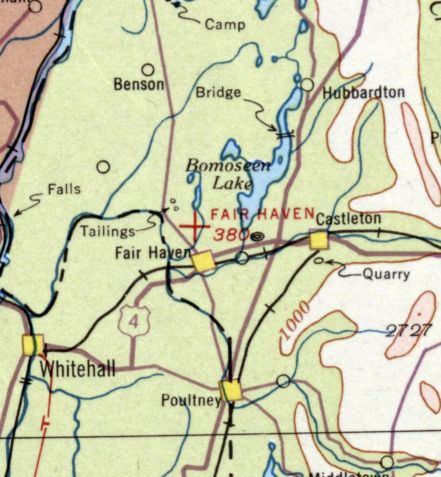
Abandoned & Little-Known Airfields:
Southern Vermont
© 2003, © 2015 by Paul Freeman. Revised 7/18/15.
This site covers airfields in all 50 states: Click here for the site's main menu.
____________________________________________________
Please consider a financial contribution to support the continued growth & operation of this site.
Fair Haven Municipal Airport (revised 7/18/15) - Miller Airport (revised 7/18/15)
____________________________________________________
Fair Haven Municipal Airport (1B3), Fair Haven, VT
43.62 North / 73.27 West (Northwest of Boston, MA)

Fair Haven Airport, as depicted on the August 1936 Albany Sectional Chart.
Fair Haven Airport may date back to the 1920s, as Louis Varricchio reported that it has a wooden hangar built in the 1920s.
However Fair Haven Airport was not yet depicted on the June 1933 Albany Sectional Chart.
The earliest depiction which has been located of Fair Haven Airport was on the August 1936 Albany Sectional Chart.
It depicted Fair Haven as an auxiliary airfield.

The earliest photo of Fair Haven Municipal Airport which has been located was a 10/3/42 USGS aerial view.
It depicted Fair Haven Municipal Airport as having a grass north/south runway with a single small building on the east side.

A circa 1942-45 aerial view looking north at Fair Haven Municipal Airport
from the 1945 AAF Airfield Directory (courtesy of Scott Murdock)
depicted Fair Haven Municipal Airport as having a single unpaved northeast/southwest runway.
The 1945 AAF Airfield Directory (courtesy of Scott Murdock) described Fair Haven Municipal Airport
as a 270 acre rectangular property having a single 2,000' turf north/south runway.
The field was said to have a single 100' x 48' wooden hangar,
to be owned by the Town of Fair Haven, and operated by private interests.
A 1947 aerial photo depicted Fair Haven as having a single unpaved northeast/southwest runway,
with a single building on the east side.

Fair Haven Airport, as depicted on the 1948 USGS topo map.

The 1950 USGS topo map depicted Fair Haven as a single northeast/southwest runway with 2 small buildings at the southeast end,
generically labeled as “Airport”.
A 1963 aerial photo depicted Fair Haven as having a single unpaved northeast/southwest runway,
with a single building on the east side.
No aircraft were visible on the field.

The last aeronautical chart depiction which has been located of Fair Haven Airport was on the February 1970 Albany Sectional Chart.
It depicted Fair Haven as having a 2,300' unpaved runway.
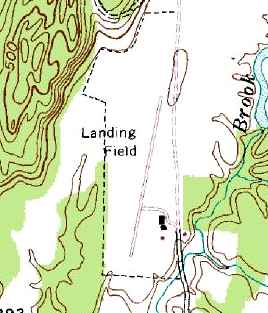
The 1972 USGS topo map depicted Fair Haven as a single northeast/southwest runway with 3 small buildings at the southeast end,
generically labeled as “Landing Field”.
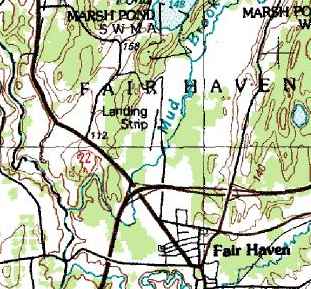
The 1989 USGS topo map depicted Fair Haven as a single northeast/southwest runway,
generically labeled as “Landing Strip”.
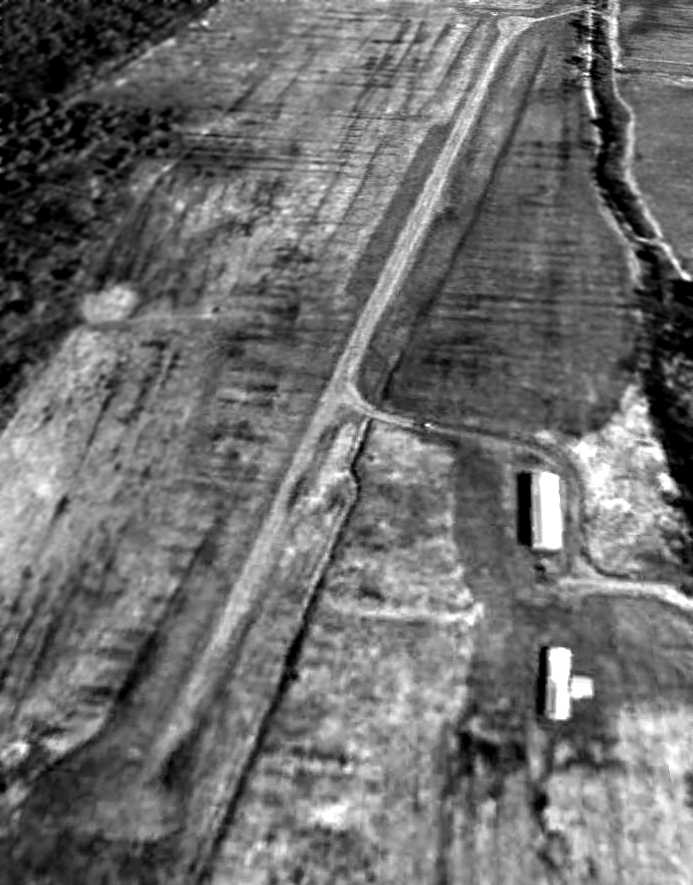
A 5/3/94 USGS aerial view looking northwest depicted Fair Haven as having a single paved northeast/southwest runway,
with 2 small buildings on the southeast end.
There were no aircraft visible on the field.
A 7/20/03 aerial view showed that a non-airport related compound
had been constructed at some point between 1994-2003 at the southeast corner of the property,
and it appeared as if the southern row of T-hangars had been relocated to the east side of the northern row of T-hangars.
Louis Varricchio reported, “I attended a 2005 air show there.
The next year I was told the town demanded insurance deposits from attendees of the upcoming airshow.
The show never happened & the airport closed.
A group submitted a nice new plan to upgrade the field. The drawings exit in Fair Haven Town Hall.
But the town officials were so dead set against aircraft bothering their precious 19th century sleep.”
A 6/5/06 aerial view showed the airport in an unchanged state.
Louis Varricchio reported, “The Fair Haven Airport was open until around the year 2006.”
According to its 2008 FAA Airport/Facility Directory data,
Fair Haven Municipal Airport had a single 2,000' gravel/dirt runway 2/20.
It conducted 150 takeoffs/landings per year, all of which were transient general aviation.
The airport was owned by the Town of Fair Haven, and the manager was listed as Jeff Shulz.
A 7/16/08 aerial view depicted 2 large yellow closed-runway “X” symbols on the runway ends.

A circa 2008 aerial view looking north depicted Fair Haven Airport as remaining completely intact.
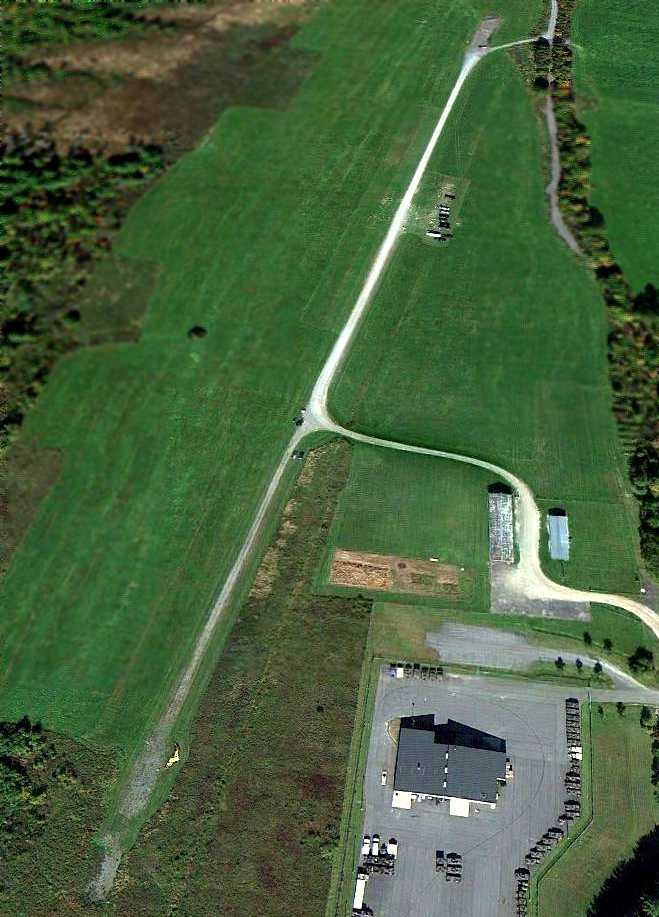
A 10/9/11 aerial view looking northwest depicted Fair Haven Airport as remaining intact,
although the width of the runway pavement appears to have contracted over time.
Louis Varricchio reported in 2011, “The Fair Haven Airport... still has the oldest standing hangar in the state (a wooden structure, built in the 1920s!).
Said to be of historic value although the town officials & most residents couldn't care less, sadly.”
Mike Denja reported in 2014 that “a recent aerial photo shows it appears to be used for radio-controlled aircraft now
and the newer building adjacent to the south is definitely used by the Vermont Army National Guard.”
Fair Haven Municipal Airport is located northeast of the intersection of Route 4 & Airport Road.
____________________________________________________
43.43 North / 72.4 West (Northwest of Boston, MA)

Miller Airport, as depicted on the 1957 USGS topo map.
“Located less than a mile from the base of Mt. Ascutney along the Connecticut river,
Miller airport was operated for 36 years by the Miller Construction company”, according to Jonathan Westerling.
According to Trumbull-Nelson’s Quarterly Construction Magazine,
the story of this airstrip revolves around O. W. Miller, known to everyone as “Chick”, who loved to fly.
In 1946, soon after finishing a project nearby,
Chick decided to stay in the Windsor area & establish his own construction company.
When he laid out the firm’s operating base between Route 5 & the Connecticut River about 3 miles south of Windsor,
he included his own landing strip.
However, no airfield at this location was yet depicted on the 1948 USGS topo map,
nor on the November 1956 Albany Sectional Chart (according to Chris Kennedy).
The earliest depiction of Miller Airport which has been located
was on the 1957 USGS topo map.
It depicted a single north/south runway with a few small buildings on the west side,
labeled simply as “Airfield”.

The earliest aeronautical chart depiction which has been located of Miller Airport was on the May 1960 Albany Sectional Chart.
It depicted Miller as having a mere 1,500' runway.
“Chick flew everywhere, nearly every day.
If he had business in nearby Lebanon, he didn’t drive.
He would jump into his plane & fly up the river”,
recalled Roger Gilman, a civil engineer, who grew up in central Vermont
and had become Miller’s “right hand” after joining the company in 1964.
The July 1964 Albany Sectional Chart (courtesy of Chris Kennedy)
depicted Miller as a public-use airfield having a 1,500' hard-surface runway.
Miller's runway was extended somewhat in the next 2 years,
as the February 1966 Albany Sectional Chart (courtesy of Chris Kennedy)
depicted the field as having a single 2,000' paved runway.
The 1967 AOPA Airports USA Directory (according to Jonathan Westerling)
described Miller as being a public but unattended airport,
having a single 1,500’ north/south gravel runway.
Evidently the airfield was paved sometime thereafter.
When Roger came to work on 3/22/82, he carried tragic news.
Miller & his good friend, Dave Hall who owned Gateway Motors in White River Junction,
had been killed when Miller became disoriented while trying to fly through a snowy whiteout
and crashed in North Stratford, NH.
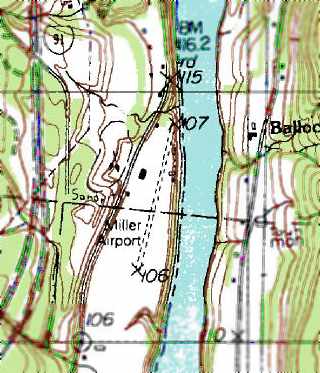
The 1984 USGS topo map depicted Miller Airport as having a single north/south runway,
with two small buildings on the west side.
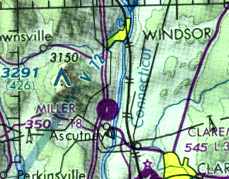
The 1984 NY Sectional Chart (courtesy of Jonathan Westerling)
depicted Miller as having a single 1,800' paved runway.
Miller Airport evidently was closed at some point between 1984-88,
as it was no longer listed at all in the 1988 Airports USA Directory (according to Jonathan Westerling).

A 1994 aerial view looking northwest showed Miller Airport to still be completely intact,
with the hangars on the west side of the field still standing,
and the entire length of the runway still extant, though marked with closed-runway “X” symbols.
Trailers were stored on the southern portion of the runway.
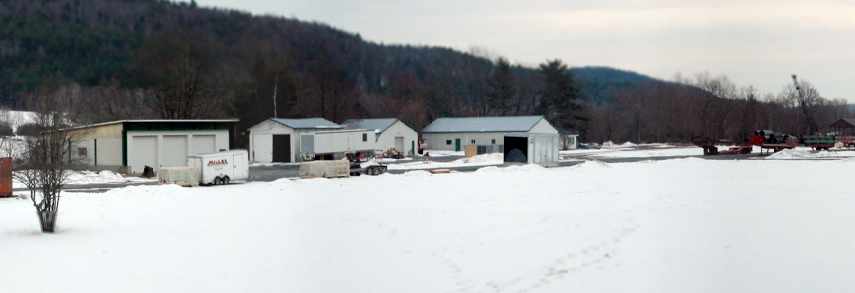
A January 2006 panorama by Jonathan Westerling of the snowy scene at the former Miller Airport.
Note that the former hangar (on the left) was converted at some point to a 3-port garage, and the runway still remains as well.

A circa 2006-2010 aerial view looking north showing the former Miller runway & hangars.
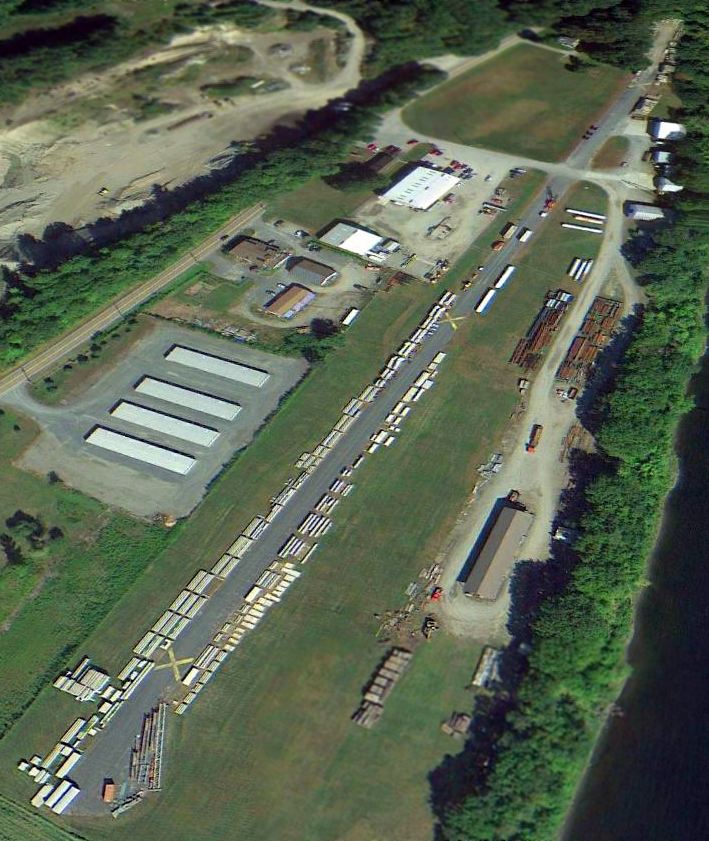
A 2014 aerial view looking northwest showed the Miller runway & hangars remained intact.
The site of Miller Airport is located northeast of the intersection of Route 5 & Route 44A.
Thanks to Jonathan Westerling for pointing out this airfield.
____________________________________________________
Since this site was first put on the web in 1999, its popularity has grown tremendously.
That has caused it to often exceed bandwidth limitations
set by the company which I pay to host it on the web.
If the total quantity of material on this site is to continue to grow,
it will require ever-increasing funding to pay its expenses.
Therefore, I request financial contributions from site visitors,
to help defray the increasing costs of the site
and ensure that it continues to be available & to grow.
What would you pay for a good aviation magazine, or a good aviation book?
Please consider a donation of an equivalent amount, at the least.
This site is not supported by commercial advertising –
it is purely supported by donations.
If you enjoy the site, and would like to make a financial contribution,
you
may use a credit card via
![]() ,
using one of 2 methods:
,
using one of 2 methods:
To make a one-time donation of an amount of your choice:
Or you can sign up for a $10 monthly subscription to help support the site on an ongoing basis:
Or if you prefer to contact me directly concerning a contribution (for a mailing address to send a check),
please contact me at: paulandterryfreeman@gmail.com
If you enjoy this web site, please support it with a financial contribution.
please contact me at: paulandterryfreeman@gmail.com
If you enjoy this web site, please support it with a financial contribution.
____________________________________________________
This site covers airfields in all 50 states.